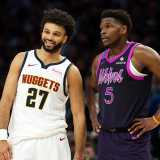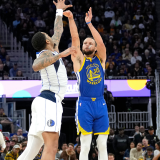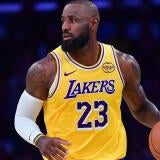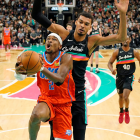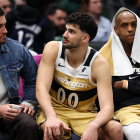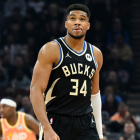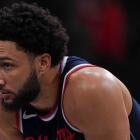
2014 Offseason Report: Indiana Pacers
The Paul George injury takes command of the Indiana Pacers' offseason.

More Offseason Analysis: Coaching changes, news | Free Agency | Draft
Over the next month, CBSSports.com's Eye On Basketball will take a team-by-team look at the 2014 NBA offseason. We continue with the Eastern Conference’s No. 1 seed last season, the Indiana Pacers. Check out the rest of the offseason reports here.
(NOTE: Pacers' offseason report was scheduled for Saturday prior to Paul George's injury)
How they finished 2014
The Indiana Pacers were one of the most enigmatic teams in the 2013-14 season. Through the first three months of the season, they looked as ready to contend for the NBA title as any team out there. In the final 2.5 months of the season, things completely fell apart for Indiana. They were still a good defensive team but their offense was abysmal and they looked uncomfortable trying to replicate the identity they had carved out under Frank Vogel. The Pacers nearly lost in the first round to the 8-seed Atlanta Hawks, rallying from a 3-2 deficit to win the series.
They lost Game 1 of their second round series against the Washington Wizards and looked to be completing the self-destruction they tinkered with in the first round. However, they rallied quite nicely and beat the Wizards in six games. In the Eastern Conference finals, they once again fell to the Miami Heat. It was the third time in three years the Heat eliminated them from the playoffs, this time in six games. They bounced back decently considering how bad the second half of their season was, but the distractions and inconsistent play were just too much to overcome against the Heat.
While it has nothing to do with the end of the 2014 playoffs for the Pacers, we'd be remiss if we didn't mention the gruesome Paul George injury at the USA Basketball scrimmage in Las Vegas. It changes everything we thought about the Pacers this offseason and what they are moving forward into the 2014-15 season.
Offseason needs
Their first order of business heading into the offseason was figuring out how to retain Lance Stephenson without going deep into the tax. They also needed to add 3-point shooting to their attack and preferably a secondary ball handler. The Pacers had to handle Stephenson's free agency with care because he was hoping to break into eight figures per season and they're pushed up against the luxury tax. Even with the tax number rising to $76.8 million, the Pacers didn't have a lot of wiggle room if they wanted to keep Stephenson and still add to their roster.
They had the mid-level exception to use, but they wouldn't have been able to re-sign Stephenson to a big deal, use the MLE, and still avoid the luxury tax. With Stephenson's antics in the Eastern Conference finals against LeBron James, he lost some suitors and any potential bidding war for his services, but he still had enough talent and production to warrant a competitive offer from somewhere.
Rasual Butler, Andrew Bynum, and Evan Turner were also free agents for the team, but neither seemed to be priorities to re-sign.
The draft
The Pacers had zero presence at the draft. Their first round pick (No. 27) belonged to the Phoenix Suns due to the Luis Scola trade. The Pacers received Scola in exchange for Miles Plumlee, Gerald Green, and the first round pick. The Suns took Bogdan Bogdanovic with the pick. In the second round, the Pacers held the 57th pick, but sold it to the New York Knicks on draft night. The Knicks took Louis Labeyrie with the pick and the Pacers walked away with nothing from the 2014 draft.
Free agency and trades
The Pacers started off their offseason by trying to find a way to strike a deal with Stephenson. They offered him a five-year deal worth $44 million, which is promptly declined. With Jodie Meeks getting three years and $19 million as a shooting guard for the Detroit Pistons and then the Boston Celtics giving Avery Bradley four years and $32 million, the market for a good shooting guard seemed much higher than what Stephenson was offered. But he didn't have a lot of teams knocking at his door to sign him immediately.
Indiana quickly signed Damjan Rudez to add some 3-point shooting. The 28-year old Croatian stretch-4 signed a three-year deal for about $3.4 million. The Pacers then signed swingman C.J. Miles with their mid-level exception. He received four years and $17.9 million. The Miles signing gave the Pacers a little wiggle room for losing Stephenson. They could revisit with their starting shooting guard and try to take advantage of a market that looked pretty dry. While Miles isn't the defender and playmaker Stephenson is, he's a much better shooter and can stretch the floor for a middle-of-the-road outside shooting team.
Stephenson had other plans. He accepted a three-year, $27.4 million deal from the Charlotte Hornets, leaving the Pacers far behind. Indiana looked for a bargain signing that could be a scorer and a ball handler off the bench. They managed to grab Rodney Stuckey on a one-year minimum deal, which sounds like a steal even if you don't think much of Stuckey's game. The seven-year veteran combo guard is a good scorer and a decent playmaker, although he can't shoot at all from outside.
One other notable thing from their offseason improvement is Roy Hibbert did a one week workout with Kareem Abdul-Jabbar. If it can help him add to his offensive game, it could be a nice boost for the Pacers.
Overall grade and accomplishments: Incomplete
The Paul George injury changes everything we thought we knew, were learning, or could question about the Pacers' offseason. None of it seems to matter anymore. Miles and Stuckey are quality signings, but in the aftermath of such a horrific injury that might cost George at least the year, this team has a lot to figure out. Figuring those things out won't come for quite some time, nor should they. Once George is out of surgery and they have a timetable for when he might be able to return, they can start planning out the future of this roster and how it can maintain in the meantime.
But none of that really seems relevant just quite yet. This is a team in transition, but they're also going to be much more concerned with being there for George. Until we see how they begin to regroup and what they have to say about themselves and the situation at the beginning of training camp, it all seems entirely too speculative to expand upon.


